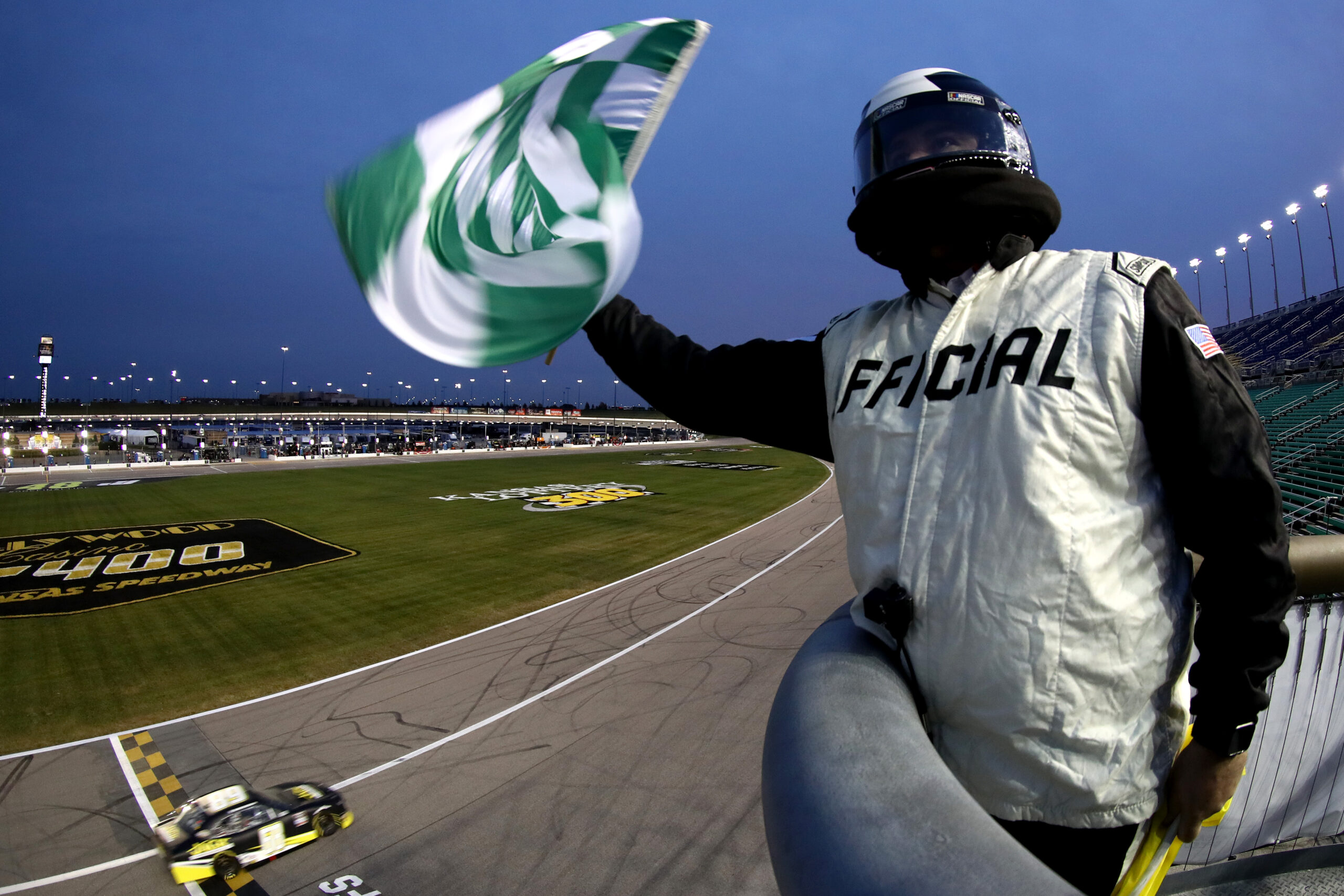
NASCAR Overtime is one of the most controversial rule changes in modern NASCAR. Multiple races in the last two decades have been extended due to NASCAR Overtime, originally called the “Green White Checkered” rule. What is the complete history of NASCAR Overtime?
In 1995, NASCAR introduced a new racing series, the Craftsman SuperTruck Series (Now Craftsman Truck Series). The series also introduced the new “Green White Checkered Rule”.
The rules were similar to how modern NASCAR overtime was enforced, with one major exception. There was only one attempt at the “Gree White Checkered” finish to complete the race under green, so, if a caution came out at any point during the attempt, the race was over.
In the Cup Series, however, if a caution came out late in the race, NASCAR would simply let the race end under caution if they couldn’t clean up the track in time. From 1997 until 2000, 3 of 4 Daytona 500 ended under the caution flag. Perhaps the most famous example came in 1998 when Dale Earnhardt won the race under caution.
However, finishes under caution left many fans with a bitter taste in their mouth, as an anticlimactic crawl under the checkered flag was not what they paid to see. NASCAR tried to rectify this issue in two ways.
First, they would throw a red flag late in the race to ensure the race would restart before the race ended. This came into play during the 2002 Daytona 500 when Sterling Marlin was penalized for working on his car under caution.
NASCAR rules at the time also stated that when a caution flag came out, drivers would race full speed back to the start-finish line, officially starting the caution on the next lap. However, safety issues arose as cars trying to ease to the caution flag interfered with drivers hustling to get their laps back or racing for position.
NASCAR axed that rule in late 2003, instead freezing the field when the caution came out. This led to a controversial finish in 2004 at Talladega, where Jeff Gordon and Dale Earnhardt Jr. were battling for the win. Gordon took home the win, but, fans were not happy.
This prompted NASCAR to make a change.
In the middle of the 2004 season, NASCAR implemented the “Green White Checkered” rule into the Cup Series. The rule was first used during the Brickyard 400 at Indianapolis, a race Jeff Gordon went on to win.
However, the race it starred in was the 2004 Ford 400 at Homestead-Miami Speedway. A tight Championships battle came down to the bitter end of the season finale at Homestead-Miami, and a “Green, White, Checkered” finish saw a frantic battle for the Championship. Jeff Gordon and Jimmie Johnson tried to fight for the Cup, but, Kurt Busch held on to win his only title.
The new rule created a green flag finish to the most critical race in, at the time, the closest Championship battle in NASCAR history. However, the rule was far from perfect.
Since there was only one attempt allowed, any caution flag during Overtime would end the race. The 2007 Aaron’s 499, for example, had an Overtime attempt that lasted less than a half lap.
After the 2009 season, NASCAR decided to make another change to the “Green-White-Checkered” rule. This time, expanding the number of attempts.
In 2010, NASCAR expanded the “Green White Checkered” rule from 1 attempt to 3 attempts. The rule was put to test early in the season, as the 2010 Daytona 500 saw 2 attempts, and, the race ended under green.
The Talladega race later that spring saw the race go to 3 attempts for the first time. That race ended under green as well, so, the rule change seemed to do what was intended. Allow more races to end under green.
However, the additional attempts caused the end of superspeedway races in particular to turn into demolition derbies. More cars were getting torn up as the races were extended, increasing the intensity, and leading to more crashes.
In 2015, during the Playoffs, NASCAR announced that there would only be 1 “Green White Checkered” attempt at Talladega. Sure enough, the race went into Overtime, and, well, the rest is history.
The field wrecked once, seemingly ending the race, only for NASCAR to claim that did not count as an attempt since the field had not crossed the line yet. On the next attempt, the field wrecked again, thanks to Kevin Harvick turning Trevor Bayne. The problem was that Kevin Harvick could not keep up with the pack due to an engine issue, and, if the race went back green, he would lose too many positions and be eliminated from the Playoffs.
Make of that what you will.
Regardless, NASCAR decided to change the rules again for the 2016 season, implementing the “Overtime Line”
To counteract the disaster of a race that was the 2015 fall race at Talladega, NASCAR brought the “Overtime Line” into play. The rule was that there were now unlimited attempts at Overtime, but, once the cars passed the “Overtime Line”, a caution would end the race.
This made for some controversial moments as NASCAR was forced to decide whether or not they could make it half a lap without crashing instead of a full lap. The 2017 summer Xfinity Series race at Daytona is one example.
Fans hated this rule. Later in 2017, NASCAR got rid of the “Overtime Line”…sort of.
In late 2017, NASCAR decided to “Move” the Overtime Line to the start-finish line. This essentially meant that Overtime rules were the same as 2004-2015, except that attempts were now unlimited. NASCAR has not messed with Overtime since.
Overtime has had its good moments in recent years. The 2022 Daytona 500, for example, was a great finish created thanks to Overtime.
However, it has not prevented races from ending under caution. One such example was the 2024 Daytona 500, where an ill-timed wreck meant that the caution did not come out until just after the white flag, ending the race under yellow.
Overtime has a complicated history in NASCAR. In nearly 3 decades of existence, NASCAR has constantly tinkered with it. Has it now been perfected?
